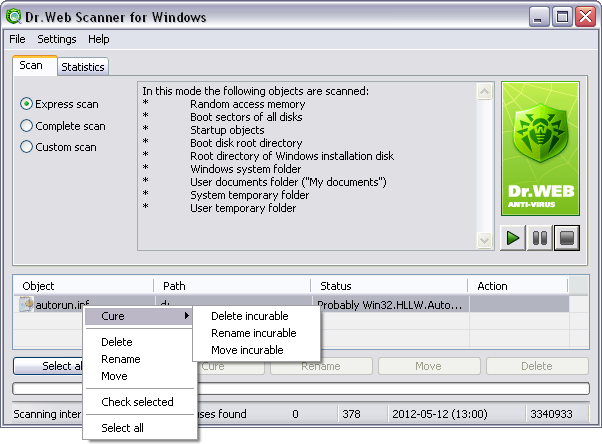If a known virus or a suspicious object is detected, the action for this object can be set by the following ways:
1.By default, Scanner informs a user about detected threats in the report field located at the bottom of the Scan tab. Infected processed in computer memory are terminated automatically and trojan programs are deleted. After this, user is able to select further actions for concrete detected objects (for details, see Setting the Action for Detected Threats).
2.If in Scanner settings on the Actions tab, the Prompt on action option is disabled, Scanner automatically, without prompt a user, applies reactions, specified on the Actions tab, to the detected threats (for details, see Action Tab).
Setting the Action for Detected Threats
By default, if a malicious object is detected, Scanner informs you about the threat (except jokes, riskware and hacktools which are ignored by default). Information on the scan displays in the report where you can manually select a necessary action for detected object.
The report table displays information on malicious or suspicious objects detected during the scanning and the actions made by Scanner. If represented objects are detected within file archives, mail boxes or file containers, the report lists these infected objects and the containers containing them.

For details on a certain option, click a corresponding item in the picture.
The following actions for detected virus threats are available:
Action |
Description |
Cure |
Restore the original state of an object before infection. When you select this action, an additional context menu appears that prompts you to select the Scanner action to perform if the curing fails. This action is available for known curable viruses only except Trojan programs and files within complex objects such as archives, mail boxes or file containers. This is the only action available for boot sectors. |
Delete |
Delete the object. This action is impossible for boot sectors. |
Rename |
Change the extension of the object file according to Scanner settings. By default, the first symbol of the extension is replaced by the # symbol. This action is impossible for boot sectors. |
Move |
Move the object to the special Quarantine folder specified by Scanner settings. This action is impossible for boot sectors. |
To perform an action to neutralize the thread
1.Select an object in the report table. To select several object, hold SHIFT or CTRL. You can also use the following keys and key combinations:
•Insert – select an object and move the cursor to the next position;
•Ctrl+A – select all objects;
•the * key on the numeric keyboard to select all or clear the selection.
2.Do one of the following:
•Right-click any selected object and select the necessary action.
•Click the appropriate button below the report table.
|
Any actions for separate files within complex objects such as archives, mail boxes or file containers are impossible. Action can be performed to the whole object only. By default, when you select the Delete action for a complex object such as archives, mail boxes or file containers, Dr.Web Scanner displays a warning message that data might be lost. |
To access different windows, menus and functions, you can also use ![]() hot keys
hot keys
F1 - help; F3 - main window, the Scan tab; F4 - main window, the Statistics tab; F5 - scan path and mask window; F7 - scan RAM and startup objects; F8 - start the automatic updating utility; F9 - Scanner settings tabs; F10 - switch to the main menu; CTRL+F5 - begin scanning; CTRL+F6 - stop scanning; CTRL+F2 - clear report list; ALT+X - exit. |